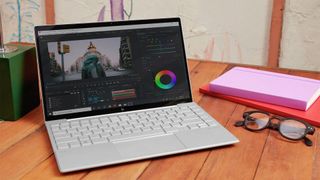Here at Creative Bloq, we test laptops, PCs, Macs and workstations on their value as well as their specs and computing power. We like to rate products in context of the broader market, the tech they offer and the price being asked.
But of course, we also test the performance and design of each computer and device, and this can include consistent testing of battery life, screen colour balancing and CPU performance. Below are the specifics on how we review laptops, desktop PCs and workstations. For our more general guidelines for reviews, see how we test and review.
Build and design

A key part of any review is establishing if a product's build quality is up to scratch, as well as taking a closer look at the design and how the manufacturer has considered a device's use. We consider the materials used, how the product feels to the touch, and whether its design work for the intended use. Importantly, we also question whether the design takes this type of product to a new level.
We look at a product's durability and test it over the course of weeks to check if it can withstand the kind of everyday uses a designer, artist or animator may put it through.
We check for tone and brightness, establish clarity of a screen and assess if the keyboard (or pen / stylus) can hold up to heavy use.
Ports, switches and any peripherals are also taken into account to assess if the product's designer has considered how everyone will use the device or only a select group of users. For laptops, we check for tone and brightness and the clarity of a screen and assess if the keyboard (or pen / stylus with relevant tablets) can hold up to heavy use. We also establish the basics – such as weight, size and handling – after all, there's little point to a laptop that's too heavy to carry.
Updating the product

Every laptop or desktop test begins with us updating the device and ensuring the system has the latest patches, firmware and drivers. Every product for review must be updated to ensure it's running the latest software it can.
Before testing, we also ensure products are set to the correct modes, for example we turn on High-Performance Mode on laptops as this ensures the integrated graphics and other components will operate at their maximum capacity. You may never need the CPU and GPU to be this overworked, but in doing so we get to test every laptop and workstation on a similar playing field.
Our testing benchmarks explained

For our main laptop, gaming PC and workstation reviews, we put every device through the same benchmark tests, and each review contains the results of these tests so we can compare them against competing devices in the same categories. Each machine is set at the same high-performance level for all tests save for battery life to ensure a stable review process.
A number of 'synthetic' tests are used to determine the performance of the device's components. The PCMark 10 battery life test is used to test a laptop's battery. We also like to back this data up with an 'in use' test, such as continuous video playback. We choose the same video and settings for each test.
A number of 'synthetic' tests are used to determine the performance of a device's components
When it comes to putting the device's GPU through its paces, we make use of the 3DMark benchmark. This tests the graphics processor with a selection of 3D modelling and video game physics tests.
The CPU gets its own bespoke benchmark too. We use Geekbench 5 to measure the system's multi-core and single-core throughput and Maxon's Cinebench R20 to determine the setup's hyperthreading capabilities. We run each of these performance tests three times to find the average rating.
Read more:

